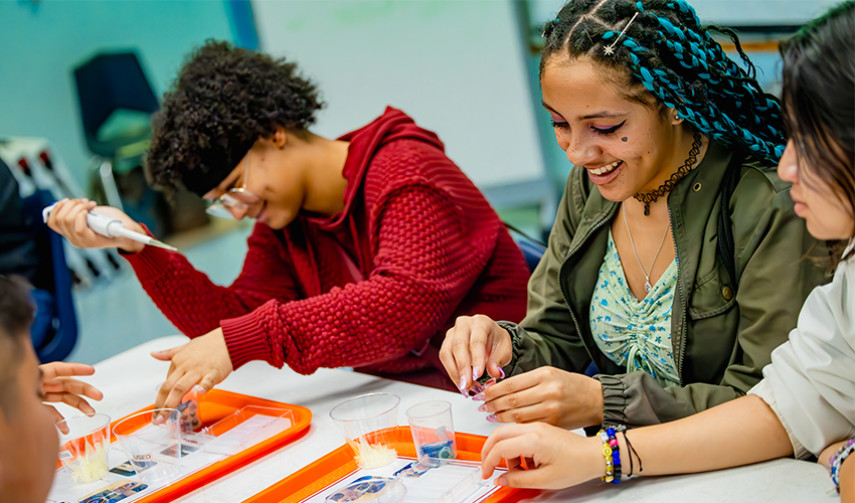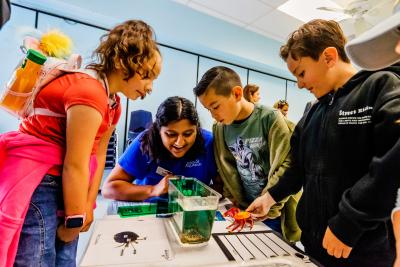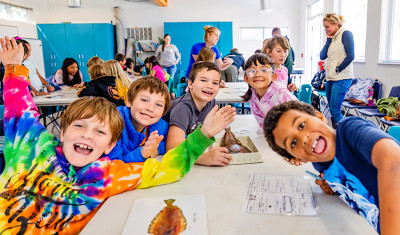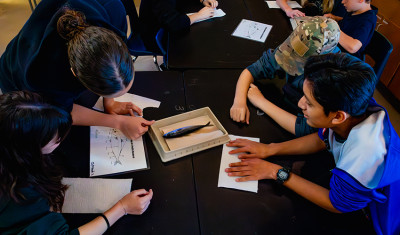Discovery Labs
Plan Your Discovery Lab
Registration for the 2025-2026 school year opens August 12!
Provide your students with NGSS-aligned, hands-on programs led by our educators that connect your students to exciting ecosystems, animals and cutting-edge scientific research! Plan for your Discovery Lab and help your students make the most of this opportunity!

Policies
Please review program information and policies before booking a Discovery Lab.
- Chaperones
Adults within the designated number are free of charge and will serve as the chaperones in the Discovery Lab classroom. These chaperones are required and expected to participate in the activities. ALL TEACHERS, STAFF, AND PARENTS with your group are categorized as chaperones per Discovery Lab program.
- Ages 2-TK: One teacher and up to 11 free chaperones per lab booked.
- Grades K-12: One teacher and up to 6 free chaperones per lab booked.
- Nurses/Aides: Free, not included in calculation of chaperone.
- Extra chaperones: $29.95 per adult
Extra chaperone tickets are available for purchase through your group order or onsite at check-in. Extra chaperones will not be permitted in the Discovery Lab classroom due to capacity restrictions.
- Program Capacity
There is a maximum capacity for your program and student numbers cannot exceed this capacity.
- Ages 2-TK: 24 students maximum
- Grades K-2: 25 students maximum
- Grades 3-12: 36 students maximum
Siblings are not included in the program price and are not allowed in the Discovery Lab. Siblings ages 3 and up will require extra payment at check-in.
- Cancellation/Rescheduling
Cancellations, changes, and rescheduling must be made 3 weeks in advance. You will be responsible for a fee of $50 per program if your program is canceled or rescheduled less than 3 weeks in advance. No refunds are provided if you do not show up for your program and you will be responsible for full payment.
Learning Resources
Explore our Pre and Post Program Resources, which will enhance several of our NGSS-aligned Discovery Lab programs. Our Activity Sheets provide additional learning opportunities for you and your students as you explore on your own.
Pre and Post Program Resources
Discovery Lab Programs by Grades

Ages 2-TK
Introduce pre-Kindergarten students to ocean habitats and organisms. Through guided explorations, students observe how animals feel, move, and behave while building investigation skills.
Program Capacity: 24 students maximum
Price: $310
- Meet and Greet the Sea
Swim, crawl, walk: there are a lot of ways to get around in the sea. Learn how different animals move through play and animal interactions. Live animal touch included.
Science Concepts:
- Properties and Characteristics of Living Things
- Observation and Investigation

Grades K-2
Explore the wondrous ocean habitats of the Kelp Forest, Sandy Shores and Tide Pools. Students in the early elementary grades put their observation skills to use to understand patterns of how different animals survive in these unique habitats.
Program Capacity: 25 students maximum
Price: $380
- Colossal Kelp (Grades K, 1)
Dive into the wonderful world of kelp as students learn about the kelp bed habitat and meet the amazing critters that call this underwater forest habitat home. Live animal touch included.
NGSS Alignment:
- DCI: LS1.C: Matter and Energy Flow in Organisms; ESS3.A: Natural Resources
- CCC: Structure and Function; Patterns
- SEP: Analyzing and Interpreting Data; Engaging in Argument from Evidence
- Tide Pool Treasures (Grades K, 1)
Students explore the world of tide pools and learn how tide pool creatures find food, protect themselves, and move in this dynamic habitat. Live animal touch included.
NGSS Alignment:
- DCI: LS1.C: Organization for Matter and Energy Flow in Organisms; ESS3.A: Natural Resources
- CCC: Patterns; Structure and Function
- SEP: Analyzing and Interpreting Data; Engaging in Argument from Evidence
- Fascinating Fish (Grade 1)
What makes a fish a fish? Through exploration of a real fish specimen, students will investigate the unique structures of a fish.
NGSS Alignment:
- DCI: LS1.A: Structure and Function
- CCC: Patterns, System and System Models
- SEP: Constructing Explanations
- Sandy Shores (Grade 2)
How does water affect the sandy shore habitat? Students explore what sand is made of, how it is created, and the animals that live in the sand. Live animal touch included.
NGSS Alignment:
- DCI: LS4.D: Biodiversity and Humans, ESS2.A: Earth Materials
- CCC: Patterns, Cause and Effect, Structure and Function, Stability and Change
- SEP: Argument from Evidence, Constructing Explanations

Grades 3-5
Let your students get their hands on an understanding of structure and function with our Dissection Discovery Labs, or learn how we are connected to and impact the creatures of the ocean.
Program Capacity: 36 students maximum
Price: $380
- Fish Diversity (Grade 3, 4)
Through hands-on exploration of biofacts and specimens, students will develop an understanding of the roles that adaptations in body shape, coloration, and teeth play in enabling fish to survive in diverse habitats.
NGSS Alignment:
- DCI: (Gr. 3) LS4.C: Adaptation (Gr. 4) LS1.A: Structure and Function
- CCC: Patterns, Cause and Effect
- SEP: Constructing Explanations, Argument from Evidence
- Creatures of the Kelp (Grades 3, 5)
Discover an underwater forest and its importance to marine organisms. How can changes in the environment affect this ecosystem? Live animal touch included.
NGSS Alignment:
- DCI: (Gr. 3) LS2.C Ecosystem Dynamics, Functioning, and Resilience, (Gr. 5) LS1.C: Matter and Energy Flow in Organisms
- CCC: Systems and System Models
- SEP: Developing Models; Analyzing and Interpreting Data
- Fish or Squid Dissection (Grades 4, 5)
Examine fish or squid inside and out through dissection of the animal.
- Grade 4 students will discover the structures that help the animal to swim, eat, and protect itself in the open ocean habitat.
- Grade 5 students will explore the role of the animal in the food chain based on their body structures and functions.
NGSS Alignment:
- DCI: (Gr. 4) LS1.A: Structure and Function, (Gr. 5) LS2.A: Interdependent Relationships in Ecosystems; LS2.B Matter and Energy Transfer in Ecosystems
- CCC: Systems; Structure and Function
- SEP: Constructing Explanations; Argument from Evidence; Obtaining, Evaluating, and Communicating Information

Grades 6-8 and 9-12
Let your students become scientists through a dissection or exploration of an ocean phenomenon, learning about structure and function through an organism or systems approach.
Program Capacity: 36 students maximum
Price: $380
- Diving into DNA (Grade 8)
How do scientists use genetics to maintain healthy seahorse populations? Through an investigation of natural and artificial selection, seahorse biology, genetics, and technologies such as gel electrophoresis, students will work as scientists to create a breeding plan for Birch Aquarium’s seahorse population that maximizes genetic diversity.
NGSS Alignment
- DCI: LS4.B: Natural Selection
- CCC: Cause and Effect
- SEP: Constructing Explanations and Designing Solutions, Obtaining, Evaluating, and Communicating Information, Developing and Using Models
- Fish or Squid Dissection (Grades 6, 7 and 9-12)
As scientists, students use the mackerel or squid as their model subject.
- Grade 6 students will identify animal structures and their functions, as well as determine the system to which they belong.
- Grade 7 students will explore how the adaptations of the animal help them avoid predation and compete for resources within their ecosystem.
- Grades 9-12 students deepen the exploration of animal structures and their functions to discuss how the interactions of their systems help the animal survive.
NGSS Alignment:- DCI: (Gr. 6, 9-12) LS1.A: Structure and Function, (Gr. 7) LS2.A: Interdependent Relationships in Ecosystems
- CCC: Structure and Function, Systems, Cause and Effect
- SEP: Constructing Explanations, Engaging in Argument from Evidence, Obtaining, Evaluating, and Communicating Information
- Deep Sea Debris (Grades 9-12)
Discover how human activity is impacting deep sea ecosystems. Students will collect data on the prey and plastics found in the stomachs of a deep sea predator, the longnose lancetfish, to understand how pollution impacts every part of our ocean planet.
NGSS Alignment
- DCI: LS2.C: Ecosystem Dynamics, Functioning, and Resilience
- CCC: Asking Questions and Defining Problems; Analyzing and Interpreting Data; Constructing Explanations and Designing Solutions
- SEP: Cause and Effect; Stability and Change